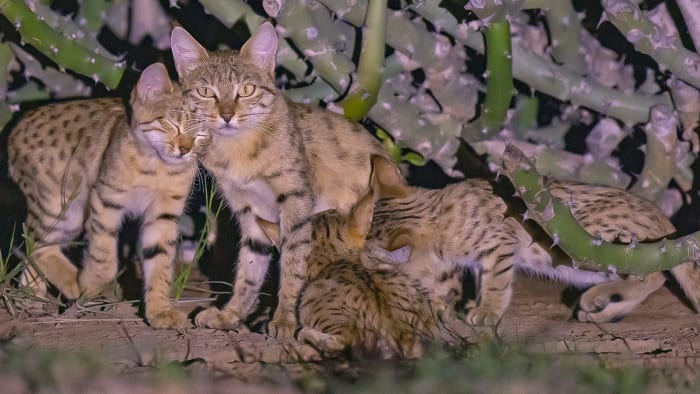 Listen to this article
•
15:34 min
Listen to this article
•
15:34 min
Almost as elusive as the Asiatic wildcat (Felis lybica ornata) is the information about it. Possibly the closest ancestor of the domestic cat, the shy Asiatic wildcat, also known as the Indian desert cat, is a rarely seen resident of scrub forests, deserts, and arid and semi-arid regions across India. Even those fortunate enough to catch a glimpse of this very private cat often mistake it for a domestic cat because of the remarkable resemblance between them; both are from the same feline family — Felis.
Occurring in the dryland regions of Rajasthan, Gujarat, and Madhya Pradesh, the Asiatic wildcat is a subspecies of the African wildcat (Felis lybica). This petite cat has fur that varies from sandy to reddish-brown — lighter in dry regions and darker in more humid habitats — with clearly demarcated black spots and stripes. Its distinctive body characteristics are tall, slender legs and long tail, often sporting a black tip differentiating it from the domestic cat. Quite unmissable on closer inspection are the little tufts of hair on the ear tips.
Over several months in 2021, wildlife photographer Dhritiman Mukherjee had the extraordinary privilege of observing, photographing, and capturing extraordinary images of a breeding Asiatic wildcat family in Rajasthan. Sumer Singh, who lives in Deg Rai Mata Oran, first showed Mukherjee the den. Over the years, Mukherjee has sighted this cat in Rajasthan’s Desert National Park, Tal Chhapar Wildlife Sanctuary, Rajasthan, and the Greater Rann in Gujarat. But “those were mere glimpses. This was unusual and special — more detailed observation was possible,” he says. It was a great opportunity, as the wildcats had made their den in Deg Rai Mata Oran, a community-conserved oran (sacred grove) in Jaisalmer district, about 80 km from Jaisalmer city.
In Rajasthan’s arid landscape, traditional orans are often lifelines providing water, food, and shelter for people and wild beings alike. The life-sustaining Deg Rai Mata Oran is considered one of the state’s largest sacred groves, with around 32 waterbodies and hardy vegetation like ker (Capparis decidua) and khejri (Prosopis cineraria), and succulents like euphorbia (Euphorbia caducifolia). Robust community stewardship over generations has provided threatened species of wildlife like the great Indian bustard (Ardeotis nigriceps) and Indian vulture (Gyps indicus) a safe haven within these traditional sacred groves. However, the groves are transforming rapidly, with power lines and green energy projects stretching across the landscape.




Mukherjee also observed that while the male cat shared the same den, he seemed to have an independent schedule and appeared rather aloof from the kittens. When the mother and her kittens moved dens twice, the father stayed behind in this den. In this parched landscape, euphorbia real estate is at a premium. “While waiting to see if the wildcat mother and kittens would return, I observed mongoose, wild boar, and even desert fox using the same euphorbia at different times of the day”, Mukherjee shares.


While most hunting happens on the ground, adult Asiatic wildcats have been observed climbing trees adeptly. Braver now, the kittens (left) venture above ground and learn to climb. They also learn to deal with prey, like this kitten practising with an Indian gerbil (right), the fruit of the mother’s hunt that night.
One outcome of being similar to domestic cats and living in human-dominated habitats is the threat of hybridisation. Asiatic wildcats often mate with domestic cats. Hybrid kittens look like Asiatic wildcats, but hybrid adults are easier to identify — their coats are different, and faces are flatter and not as elongated. In a country like India, where only five per cent of the land is protected, life beyond ”protected areas” in sacred groves like these are hopeful signs. It demonstrates that coexistence with local communities in safe wildernesses is possible and offers us rare glimpses into the lives of creatures like the Asiatic wildcat.














